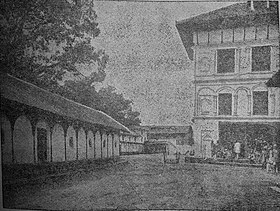This article needs additional citations for verification. (September 2013) |
| Kot Massacre | |
|---|---|
 Kot arsenal at Basantapur Durbar, Kathmandu | |
| Location | Basantapur Durbar, Kathmandu |
| Date | September 19, 1846 night (Nepal Standard Time) |
Attack type | political assassination (open court massacre) |
| Weapons | Talwar, rifle, Khukuri |
| Deaths | 30-40 civil, military officers and palace guards (including then Prime Minister of Nepal Fateh Jung Shah Kaji Dalbhanjan Pande Kaji Abhiman Singh Rana Magar Kaji Bir Keshar Pande) |
| Perpetrator | Jang brothers: (Jang Bahadur Rana, Bam Bahadur Kunwar, Bhaktabir Kunwar, Badri Narsingh Kunwar, Jaya Bahadur Kunwar, Krishna Bahadur Kunwar, Ranodip Singh Kunwar, Jagat Shamsher Kunwar, Dhir Shamsher Kunwar) Jang supporters:Rana Mehar Adhikari, Bhotu Ghale |
The Kot massacre (Nepali: कोत पर्व) took place on 14 September 1846 when then Kaji Jang Bahadur Kunwar and his brothers killed about 30-40 civil officials, military officers and palace guards of the Nepalese palace court including the Prime Minister of Nepal and a relative of the King, Chautariya Fateh Jung Shah along with other senior-most ministers and army generals at the palace armory (Kot) of Hanuman Dhoka in Kathmandu.
The Kot meeting was called upon by Queen Rajya Laxmi Devi after the same night murder of her confidante Kaji Gagan Singh Bhandari while performing worship at his prayer room. The Kot meeting turned ugly and eventually, the Jang brothers and their supporters led an open court full-fledged assault on all rival participants in the meeting. This massacre led to the loss of power of political clans such as Chautariyas, Pandes, Thapas, and Basnyats and that of King Rajendra Bikram Shah and Queen Rajya Laxmi Devi and ultimately the establishment of the Rana autocracy in Nepal.